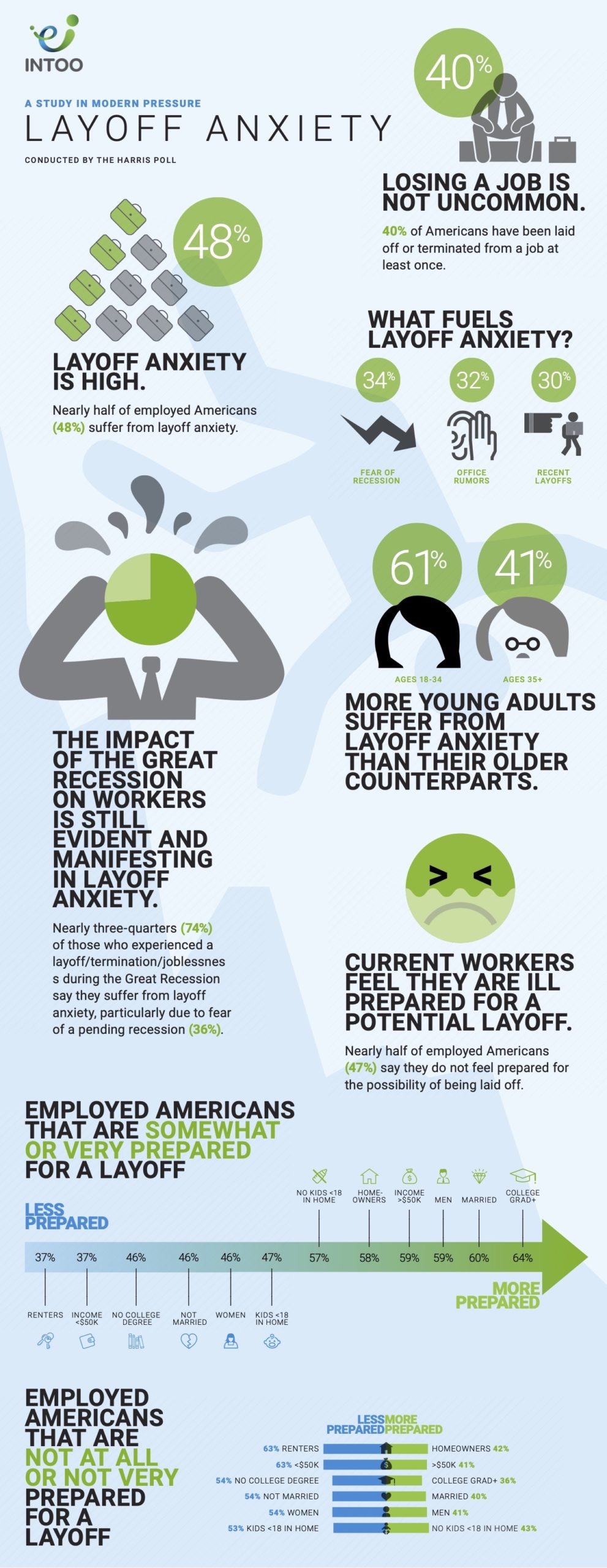Nearly half of American employees experience layoff anxiety, despite record low unemployment rates. That’s according to the INTOO Layoff Anxiety Study, a survey conducted by The Harris Poll on behalf of INTOO.
We surveyed 2,204 U.S. adults, of whom 1,061 were employed, on their thoughts and emotions about their employment status—and found that people are still strongly affected by their experiences during The Great Recession and are fearful of a pending recession.
The infographic below delves into the details of layoff anxiety: what is causing it, who is experiencing it, and how prepared American workers are for a potential layoff.
Download the INTOO Layoff Anxiety Study.
19 Eye-Opening Layoff Anxiety Stats
Losing a job is not uncommon.
- 40% of Americans have been laid off or terminated from a job at least once.
Layoff anxiety is high due to fears of a pending recession, the rumor mill, or a recent round of layoffs at work.
- Nearly half of employed Americans (48%) suffer from layoff anxiety.
- Around one-third of those say fear of a pending recession (34%), rumors around the office (32%), and a recent round of layoffs at the workplace (30%) fuels their layoff anxiety.
More young adults suffer from layoff anxiety than their older counterparts.
- 61% of young Americans ages 18-34 suffer from layoff anxiety as compared to 41% of adults ages 35+.
- 52% of employed Americans ages 18-54 feel they are not very or not at all prepared for a layoff compared to 30% of older employed Americans (55+).
The impact of the Great Recession on workers is still evident and manifesting in layoff anxiety.
- Among employed Americans who experienced a layoff/termination/joblessness during the Great Recession, 7 in 10 (68%) say they experienced joblessness, while nearly 2 in 5 (39%) were laid off and 15% were terminated.
- Nearly three-quarters (74%) of those who experienced a layoff/termination/joblessness during the Great Recession say they suffer from layoff anxiety, particularly due to fear of a pending recession (36%).
Current workers, particularly younger workers and workers impacted by the Great Recession, feel they are ill prepared for a potential layoff.
- Nearly half of employed Americans (47%) say they do not feel prepared for the possibility of being laid off.
- More than half of young workers (51% of those aged 18-34) and workers who experienced a layoff/termination/joblessness during the Great Recession (55%) feel unprepared for a layoff.
- Less experienced workers may face more challenges finding or switching jobs during a recession. Younger Americans, millennials aged 18-34 (26%) and those aged 35-44 (20%), were about twice as likely to have experienced difficulty in finding/switching jobs during the Great Recession compared to those ages 45-54 (11%) and 55-64 (10%).
While just over half of employed Americans (53%) feel somewhat or very prepared for a potential layoff, preparedness varies by several different demographic groups.
- Employed renters (37%) are less likely to feel prepared for a layoff than homeowners (58%).
- Employed Americans without children under 18 in the household (57%) are more likely to feel prepared for a layoff than those who are employed with children under 18 in the household (47%).
- Employed adults with a college degree or higher (64%) are more likely to feel prepared than employed adults with some college (48%) or a high school degree or less (43%).
- Unmarried employed Americans (46%) are less likely to feel prepared than married employed Americans (60%).
Women are less likely to feel prepared for a layoff than men.
- 46% of employed women feel somewhat or very prepared for a layoff as compared to 59% of employed men.
- 39% of employed women who suffer from layoff anxiety cite fear of pending recession as the number-one cause of their layoff anxiety, versus 29% of men in the same group.
Losing a job is not uncommon, but men are more susceptible to job loss than women.
- 40% of Americans have been laid off or terminated from a job at least once.
- 23% of those who experienced a layoff/termination/joblessness during the Great Recession have been laid off or terminated three or more times.
- Men are more likely than women to have been laid off or terminated.
- 45% of men have lost their jobs as compared to 36% of women.
- Men are more likely than women to have lost a job multiple times. 12% of men have lost a job three or more times, compared to 4% of women.
Americans without college degrees are more susceptible to job loss than college grads.
- 64% of Americans with college degrees or higher have never been laid off as compared to 48% of Americans with some college and 47% of those with a high school degree or less.
Research method: This survey was conducted online within the United States by The Harris Poll on behalf of INTOO from June 25-27, 2019 among 2,024 adults ages 18 and older, of which 1,061 were employed. Results were weighted for age within gender, region, race/ethnicity, income, and education where necessary to align them with their actual proportions in the population. Propensity score weighting was also used to adjust for respondents’ propensity to be online. This online survey is not based on a probability sample and therefore no estimate of theoretical sampling error can be calculated. For complete survey methodology, including weighting variables and subgroup sample sizes, please contact INTOO at us.media@intoo.com.
Key Takeaways for Employers
It’s time to get prepared
Since layoff anxiety is so prevalent in the U.S. workforce, it makes sense for companies to manage and address these worries head-on. Company leaders and HR professionals can take steps to both assuage unnecessary fear among employees and prepare for unexpected changes in the business environment.
By taking proactive steps to manage layoff anxiety, employers can enhance employee productivity, reduce turnover, and make nimble business decisions in reaction to inevitable economic shifts.
3 steps to manage layoff anxiety
- Communicate with employees. Much of the fuel behind layoff anxiety comes from the fear of the unknown. Thus, it’s helpful to let employees in on company decisions as much as possible—especially during times of mergers and acquisitions (M&As), management changes, or shifts in business focus. If there are no plans for layoffs in the foreseeable future, communicate that news to employees to forestall rumors. If some organizational shifts may happen, let employees know the scope of the changes as early as business conditions allow.
- Create a layoff plan. Since the need for layoffs can emerge suddenly, companies need to be prepared at all times. Layoffs can be an involved undertaking with many legal, financial, and personal details to manage. To fully plan for this event, download INTOO’s Reduction-In-Force Checklist, which outlines the 16 steps to successfully managing a reduction in force.
- Engage an outplacement service. If your company lays off employees, you’ll want to provide exiting workers with outplacement services to help them land new jobs more quickly. This will allow you to retain a positive relationship with your former employers as well as forestall lawsuits and protect your employer brand. The best time to put an outplacement plan in place is when your company is not going through a reduction in force, so that if and when the time comes, you’ll be able to put your focus on the affected employees.
INTOO’s outplacement solution offers on-demand career coaching via video and chat, detailed resume reviews, interview coaching, and many other cutting-edge tools and benefits—all available on a convenient online platform. Learn more about how our outplacement services can benefit your company.












